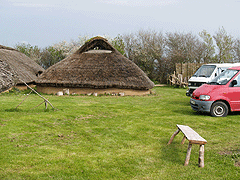 |
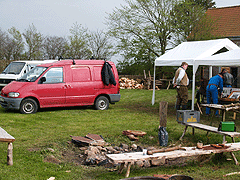 |
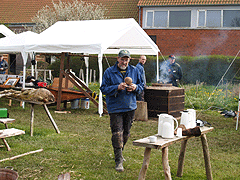 |
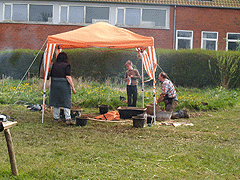 |
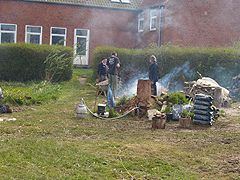 |
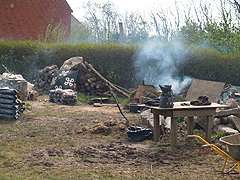 |
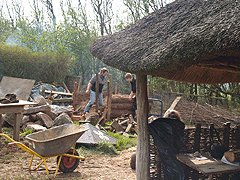 |
An overview of the Symposium site at the Heltborg Museum
Above as individual images - below as a single panorama.
Images taken looking roughly east through west.
'Iron Smelting Seminar at Thy'
EXPERIMENTAL IRON SMELTING at the HELTBORG MUSEUM
DENMARK : April 29 - May 5, 2008
An Overview
 |
 |
 |
 |
 |
 |
 |
An overview of the Symposium site at the Heltborg Museum
Above as individual images - below as a single panorama.
Images taken looking roughly east through west.
I was invited to attend this international gathering of experimenters working with various types of Northern European early iron smelters. Teams were present from England, the Netherlands, Sweden, Norway, several from Denmark, with myself from North America. There were a total of seven working teams, most of which fired at least twice over the six days. The stress was on historic furnaces and process, ranging from Early Iron Age through to Viking Age types. After a long day either smelting or in preparation, the evenings held presentations from participants or visiting archaeologists.
The Heltborg Museum is primarily a collection of Danish paintings and drawings. Attached to it is Iron Age reconstruction which is used for educational programs. The site is about 2/3 the way up the Jutland, to the west side. The large open space between the collection building and the grouping of Iron Age structures was the ground for the iron smelting activities. (The images above were taken early on Wednesday morning.)
This overview is laid out as a 'day by day' visual record of the main events. (Note that I have made my best attempt to keep the action straight and attributed to the correct individuals - sorry for any errors.)
Tuesday:
Michael Nissen of the Ribe Viking Centre worked with an 'Espevej' type furnace. This is a short shaft, 'slag room', set up with a front plate. The first working day had light rain for a good part of it. Anyone involved in furnace construction pretty much got covered in clay. |
There was a good supply of ores on hand. This all had to be roasted, which became an ongoing process over the entire symposium. This shows the rich 'Guldager' ore gathered by Michael Nissen. There was a huge amount of a local Heltborg ore available as well, but this proved to contain a lot of sand. | Jake Keen, working with his friend Michael, understood an extremely ambitious project. They constructed a quite large passive draw, wood fired furnace. This was an Iron Age slag pit type that Jake had never worked with before. | I started working with Arne Espelund on a first test of a new theoretical version of the historic iron smelting process. This involved linking two individual furnace runs. An older furnace constructed by host Jens Olesen was set up for the first part of the process. |
Wednesday:
The Tranamo Group from Sweden showed their experience with public demonstration smelts. They were highly organized, and prepared and smelted almost every day of the symposium. The ore they brought from Sweden was a rich powdery yellow ochre that consistently gave good blooms. |
Ole Neilsen and his assistant started working on a variation of the 'Evenstad' furnace. This was a wide but short shaft that fired wood. Note the wide earth packing supporting the furnace. | Jake and Michael kept at the construction of their huge furnace. As work progressed, they had made a number of modifications as ideas occurred to them. | The Esplund experiment undertook the first firing stage. The intent was to produce a quantity of high iron content slag, but not any actual iron. The furnace was ran extra rich (more ore than fuel). Arne would extract samples for latter testing after the furnace cooled. |
Thursday:
The day started pretty foul, with wind and rain. We spent the morning visiting a nearby archaeological excavation. The site was an Iron Age house complex (one of the most complex structures found to date). Related to the occupation was a burial mound, it is hoped with an untouched grave chamber (still to be opened). |
Jens Olesen finished work on his smelter. This was a tall stack, intended to be wood fired and use passive air. | Jan Jennisen constructing his short shaft, slag pit furnace. Jan was by far the most careful of all in the construction of his furnace. The result was certainly the most beautiful structure seen. The type is one found in the Netherlands, and he also brought his normal local source ore. |
Arne Espelund prepares the iron slag from stage one for use in the stage two firing, while I set up the furnace. Breaking up the slag mass was by far the most serious draw back of his suggested two step process. |
Friday:
After Michael Nissen's second firing of his furnace, he discusses the results with Robin Davies (Tranamo) and archaeologist Martin Olesen. Michael had both times gotten a crumbly high carbon bloom. He was a bit surprised at the result, and not certain why. |
The second step of the Espelund experiment was undertaken. This firing used the broken slag as the charge with the hope of producing a bloom. In the end only a few small pieces of iron were created. As Arne said 'Even an negative result is valuable experimental data'. |
Ole and his team fired their completed furnace. Although a large slag mass was created, little iron was produced on this first attempt. |
After supper, we piled into cars and got a tour of the nearby North Sea shore with Heltborg Museum Curator Jette Neilsen. On the far point can be seen the 'Black Man' geographical feature. A nice break to clear our heads for Saturday |
Saturday:
This was the main public presentation day - there were 6 smelts undertaken!
Smelts were undertaken by the teams: Tranamo / Olesen / Keen / Neilsen / Jennisen
X 2
There were a total of three wood fired smelters in operation. This process involves first the conversion of the wood into charcoal - resulting in much smoke at the initial phase. Jens' furnace in the foreground, with Jake's seen dimly in the left rear. |
Jan opening his smelter at the end of the day. Although not as successful in terms of bloom, the slag pit proved very interesting. The liquid slag had encased the carefully packed straw in the lower bowl. The effect was exactly like the archaeological remains Peter Mikkelsen had lectured on earlier in the week. |
After my description of Skip Williams' Aristotle Furnace, our youngest participant Pelle (with help from his mom) built a version. MIchael Nissen and Robin were quite taken with the simple process and spent several hours operating it. |
Sunday:
Generally this was the start of packing and cleaning up - but some smelting continued
Although Jake and Michael had started their furnace early Saturday morning, it continued working well into the late night hours. Sunday afternoon they decided to kill the reaction - after some 300 kg of ore had been added. In the image, water is being directed down inside the furnace to cool it off. The process of dismantling the furnace extended well into the evening of this second day. |
I had set up on Saturday, and on Sunday ran a smelt using the sequence normal to the North American experimenters. (Higher air and consumption rates). The ore was a blend of the Guldage, Heltborg and Tranemo types. The result was about 1.8 KG of spongy iron buried in the slag block. |
(Short Cut HERE back to the main site index / map.)
Text and photography © 2008, Darrell Markewitz